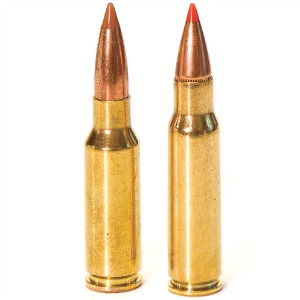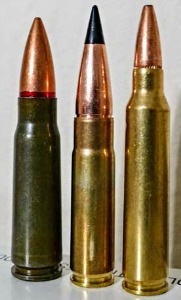|
Are AR-15 Type Cartridges Good for Hunting Deer? By Gary Zinn  Given the popularity of AR-15 type rifles, it is no surprise that a number of attempts have been made to develop or adapt cartridges of larger caliber than .22 for the AR-15 platform. Some of these creations have been touted as suitable for hunting Class Class 2 size game animals. The question that arises, however, is whether such cartridges truly have the range and terminal performance to be effective for hunting deer size game. Currently (Nov. 2017) there are seven AR-15 cartridges that merit consideration for big game hunting. Four of these are small bore cartridges (.264, .277, .308, and .310 bullet diameter), while three are big bore (.458 and .500 bullet diameter). Based on ballistics analysis, I conclude that the small bore cartridges, with one exception, are adequate for hunting deer and similar size Class 2 game. The big bore cartridges, while having plenty of downrange power, are awkward and unneeded options for hunting Class 2 game. Accordingly, I will focus detailed evaluation on the small bore cartridges, and will then briefly explain why I discount the big bore cartridges. The small bore cartridges worthy of detailed analysis include the 6.5 Grendel, 6.8 Remington SPC, .300 ACC Blackout and 7.62x39mm Soviet. I selected one hunting load for each cartridge, except that I used two loads for the .300 BLK, to make an important point. Methodology My analytical method involves coordinated use of the maximum point blank range (MPBR) concept, a ballistic trajectory calculator and the G&S Online Killing Power Formula. MPBR determination is the simplest part of the process. For a given load, the bullet ballistic coefficient, muzzle velocity and target size are entered into an online point blank range calculator. I use the one at www.shooterscalculator.com, with a MPBR of +/- 3 inches (6 inch target size). This gives me the practical maximum range of the load in question. After calculating the MPBR for a load, a ballistic trajectory calculator is used to determine bullet energy at 100 yards and at MPBR. These data are needed to calculate the KPS values for the load. The G&S Online Killing Power Formula, devised by Guns and Shooting Online Owner/Managing Editor Chuck Hawks, is used to calculate index values of the killing power of hunting loads. The formula uses downrange impact energy, bullet sectional density and bullet cross-sectional (frontal) area as the input variables. Calling the output variable of the formula "KPS" (Killing Power Score), for a given load, the formula is: KPS at y yards = (impact energy at y yards) x (sectional density) x (cross-section area), or simply: KPS = E x SD x A A KPS can be calculated for any range, because whenever any of the independent variables in the KPS formula change, the KPS number changes proportionally. For instance, if, between 100 and 150 yards, the energy of a bullet decreases by (say) 15 percent, the KPS will decrease by the same percentage. Thus, KPS numbers generated from different data inputs (energy, SD, or cross-sectional area) are directly comparable. (I discussed the proportional change characteristics of the KPS formula, along with some other issues, in The G&S Online Rifle Cartridge Killing Power Formula: Implications and Applications.) I calculated the KPS values for each cartridge and load included in this article at 100 yards and at their MPBR distance. The 100 yard KPS score is a readily comparable measure between different cartridges or loads, while the KPS at MPBR is an indicator of the power of the bullet at the maximum range that I believe a responsible hunter should attempt a shot on a game animal. (Closer is always better.) Chuck and I have studied and discussed the issue of using KPS scores to evaluate the effective killing range of cartridges and loads used to hunt Class 2 game animals. Chuck considers a KPS of 12.5 the minimum score for any deer cartridge at a given range, while I prefer a 15 KPS minimum for Class 2 game. I will use the 12.5 KPS minimum in this article, to assess the suitability of loads for hunting deer sized game (up to about 150 - 175 pounds.) Therefore, the Effective Killing Range (EKR) of any load is the distance at which the bullet has enough killing power (i.e., a KPS value of 12.5) to dependably dispatch a deer or similar size animal, assuming a vital area hit. MPBR distances are rounded to the nearest 5 yard increment, KPS values are rounded to one decimal place and muzzle velocities of loads are for 16 inch barrel lengths, since this is the most common barrel length for AR-15 type rifles. I also estimated the recoil of each load, using the www.shooterscalcualtor recoil energy calculator (for a rifle weight of eight pounds). Results 6.5 Grendel - Hornady Custom 123 gr. SST: MV 2460 fps, BC .510, SD .252; MPBR = 245 yards:
6.8 Rem. SPC - Hornady Custom 120 gr. SST: MV 2460 fps, BC .400, SD .223; MPBR = 240 yards:
These are two cartridges/loads that will work for the deer hunter. Both carry KPS power comfortably above the 12.5 minimum level to nearly 250 yards. There is no reason that these loads would not perform well on deer size game, with suitable hunting bullets and bullet placement. (Bullets weighing 115 to 130 grains give the best downrange performance in these cartridges.) In addition, the recoil of both is quite mild, about 20 percent less than that of a typical .243 Winchester deer load. Neither the 6.5 Grendel nor the 6.8 SPC can measure up to the performance of the 6.5x55SE, .260 Remington, or 6.5 Creedmoor with similar weight bullets, but these two AR-15 platform cartridges are not bad. Downrange performance of loads such as these would be enhanced in rifles with barrels longer than 16 inches. .300 ACC Blackout - Hornady Custom 135 gr. FTX: MV 2085 fps, BC .274, SD .203; MPBR = 200 yards:
.300 ACC Blackout - Jamison 150 gr. SP: MV 2035 fps, BC .380, SD .226; MPBR = 200 yards:
 These two .300 BLK loads demonstrate an important point: lower power cartridges perform better downrange with heavier bullets. The 135 grain load has an Effective Killing Range (EKR) of only 160 yards. Beyond 160 yards the KPS of the load falls below the benchmark level of 12.5. However, the 150 grain load carries a KPS of over 15 all the way out to its 200 yard MPBR. 135 grains is the minimum .308 bullet weight that has a sectional density over .200. There are a number of .300 BLK loads on the market with lighter bullets, but these will not serve well for hunting. They will have even shorter EKR distances than the 135 grain load and their low terminal energy and bullet sectional densities under .200 suggest they will not penetrate as deeply as heavier bullets with a similar expansion percentage. 150 grain hunting bullets make the .300 ACC an adequate deer cartridge at 200 yards or less, while the cartridge is deficient with lighter weight bullets. 7.62x39mm Soviet - Hornady BLACK 123 gr. SST: MV 2310 fps, BC .295, SD .183; MPBR = 220 yards:
The 7.62x39mm is a fearsome battle cartridge, but that does not make it a good hunting cartridge. Loads with 123 grain bullets are almost the only commercial hunting loads offered, with the load detailed above being typical of the lot. Two things about this load make it marginal. First, it does not carry energy downrange well. The EKR of the load (where its KPS falls below 12.5) is 185 yards, well within the 220 yard MPBR. Second, the SD of the light-for-caliber bullet is only .183. Couple this with the low energy of the bullet at extended ranges and one has a recipe for poor terminal performance on game animals. I am not planning to buy a 7.62x39mm rifle and ammo for my next deer hunt! I cannot help but judge the ballistic performance and killing power of the .300 BLK and the 7.62x39mm against that of the .30-30 Winchester. As an effective deer cartridge, the .30-30 (using 150 to 170 grain bullets) wins easily. The only way in which these two AR-15 cartridges better the .30-30 is that they have 2.5 to 3.0 foot pounds less recoil than typical .30-30 loads. Note: If anyone wonders about the .30 Remington AR cartridge, it is defunct. Remington introduced the cartridge in 2009, along with a rifle chambered for it. Ballistically, the cartridge seems entirely suitable for Class 2 game, but it fell flat in the marketplace. Remington no longer makes ammunition or rifles in the caliber and no one else supports it, either. About the big bore cartridges There are three big bore AR-15 type cartridges that bear mention, the .450 Bushmaster, .458 SOCOM and .50 Beowulf. None of these is heavily supported by either AR-15 rifle or upper receiver makers, nor by commercial hunting ammo manufacturers. (The .458 SOCOM is healthiest, while the .450 Bushmaster is almost dead.) I believe there are practical reasons why these big bore AR cartridges have achieved very limited market success. I worked the numbers for a 250 grain .450 Bushmaster load, a 300 grain .458 SOCOM load and a 325 grain .50 Beowulf load. Briefly, here are the key results. These are powerful loads, with 100 yard KPS values of 53.6 and 53.8 for the Beowulf and Bushmaster loads, respectively, while the SOCOM load has a 100 yard KPS of 58.7. KPS values at MPBR run in the high 30s to mid 40s. This seems quite impressive, for these are Class 3 game power levels. However, these are short to moderate range cartridges and loads. The MPBRs (+/- 3") are 200 yards (Bushmaster), 180 yards (SOCOM), and 165 yards (Beowulf). Bullet SDs are poor, barely over .200 for the SOCOM load and under .200 for the others; do not expect reliable, deep bullet penetration on large animals. Finally, these loads kick hard. Recoil estimates in an eight pound rifle are 21.0 ft. lbs. (Bushmaster), 23.4 ft. lbs. (SOCOM) and 25.5 ft. lbs. (Beowulf). One perspective on the performance of these loads is that they generate downrange power very close to that of a .30-06 Springfield 200 grain load, but the .30-06 has a 255 yard MPBR and a SD of .301. Add the fact that the .30-06 generates about the same recoil and I come away unconvinced that these big bore AR-15 loads do anything unique. Several more popular and more available cartridges will do as much or more than the big bore AR-15s. The 7mm Rem. Mag., .300 Win. Mag., .338 Federal, .358 Winchester, and .45-70 come quickly to mind. Heck, even a .308 Winchester, loaded with a 200 grain Swift A-Frame bullet at 2400 fps MV, has a MPBR of 240 yards and a KPS of 38.5 at that range. Ultimately, anyone who feels a need for a fast cycling, big bore thumper should seriously consider, say, a lever action .45-70 instead of a big bore AR. Conclusion The results of this inquiry are clear. The 6.5 Grendel and 6.8 Remington SPC are good deer cartridges, while the .300 ACC Blackout is adequate, as long as 150 grain bullets are used. The 7.62x39mm is not recommended for deer hunting. The big bore AR cartridges are SISOPs (solutions in search of a problem). For hunting Class 2 or 3 game, these cartridges can not do anything that several other proven cartridges cannot do better. Note: See the G&S Online Rifle Cartridge Killing Power Formula, The G & S Online Rifle Cartridge Killing Power Formula: Implications and Applications and Determining the Effective Killing Range of Rifle Cartridges for fuller discussion of the killing power formula and effective killing range concepts. |